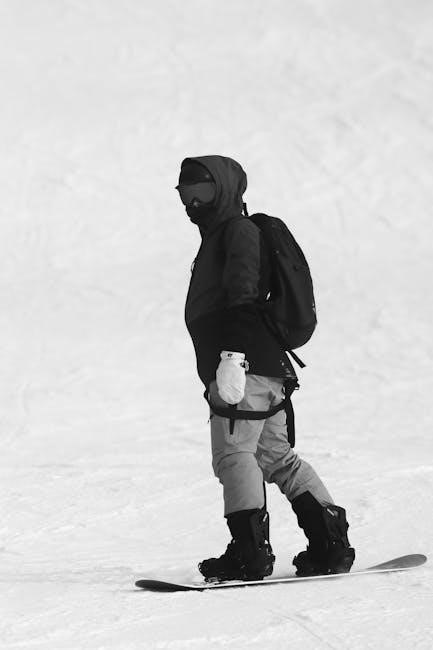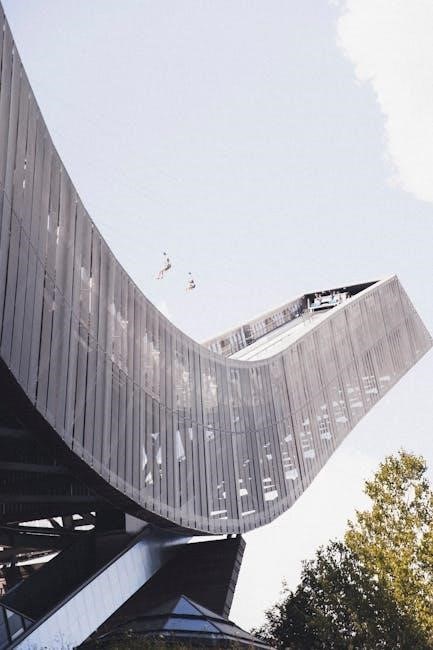Nordic skiing is a popular winter sport offering a full-body workout and connection with nature. Proper ski sizing is crucial for performance, efficiency, and enjoyment on the trails.
Overview of Nordic Skiing
Nordic skiing is a traditional and accessible winter sport emphasizing endurance and technique. It differs from downhill skiing, as it uses longer, lighter skis with free-heel bindings, allowing for a natural stride. The sport includes classic skiing, where skiers glide in parallel tracks, and skate skiing, which mimics ice skating with a more dynamic motion. Nordic skiing can be enjoyed on groomed trails, in the backcountry, or even on flat, open spaces. It provides a full-body workout while connecting users with nature, making it a popular choice for both recreation and competitive athletes.
Importance of Proper Ski Size
Proper ski size is crucial for optimizing performance, comfort, and efficiency in Nordic skiing. Skis that are too long can be difficult to control, while skis that are too short may not glide effectively; The right size ensures better balance, maneuverability, and energy efficiency, allowing skiers to maintain momentum and technique. Incorrect sizing can lead to poor performance, discomfort, or even injury. For both classic and skate skiing, appropriate ski length ensures the skis interact with the snow correctly, enhancing the overall skiing experience. Correct sizing is essential for maximizing enjoyment and effectiveness on the trails.
Factors Influencing Nordic Ski Size
Weight, height, skill level, and skiing style are key factors in determining the right ski size. Proper fitting ensures optimal performance, control, and comfort on the snow.
Skier Weight and Height
Skier weight and height play a significant role in determining the appropriate ski size. A skier’s weight affects the ski’s ability to glide and maintain floatation on snow, while height influences the ideal length for comfortable stride and technique. Generally, taller skiers require longer skis for better stability and efficiency. Conversely, lighter skiers may prefer shorter skis for easier maneuverability. Proper sizing ensures the ski responds well to the skier’s movements, optimizing performance and reducing fatigue. Weight and height guidelines, often provided in sizing charts, help narrow down the best fit for individual needs. Consulting these charts or an expert can ensure optimal selection.
Skier Skill Level and Experience
A skier’s skill level significantly influences the choice of ski size. Beginners benefit from shorter skis, which are easier to maneuver and provide stability, enhancing learning and confidence. Advanced skiers can opt for longer skis, offering better glide and speed, suitable for more aggressive techniques. Skill level also affects ski flex and camber selection; stiffer skis suit experienced skiers for superior performance, while softer flex is ideal for those developing their technique. Aligning ski choice with skill level ensures optimal performance and enjoyment on the trails, catering to individual needs and progression in the sport.
Type of Skiing (Classic vs. Skate)
The type of skiing—classic or skate—plays a key role in determining ski size. Classic skiing typically uses longer, narrower skis with a more pronounced wax pocket for traction in prepared tracks. Skate skiing, designed for speed, utilizes shorter, wider skis with less camber to enable powerful, dynamic movements. Classic skis usually range from 180 to 210 cm, while skate skis are shorter, around 160 to 190 cm. Each style requires specific ski dimensions to optimize performance, ensuring efficiency and control in their respective techniques, making it essential to choose skis tailored to the skiing style. This ensures a better experience on the snow.

How to Choose the Right Ski Length
Proper ski length is determined by balancing height, weight, and skiing style. A well-fitted ski ensures optimal performance, efficiency, and control, enhancing the overall skiing experience;
Determining the Optimal Ski Length
Optimal ski length is determined by balancing height, weight, and skiing ability. Generally, taller skiers require longer skis, while shorter skiers need shorter ones. Weight also plays a role, as heavier skiers benefit from longer skis for better floatation. Skill level matters too—beginners may prefer shorter skis for easier control, while experienced skiers can handle longer skis for increased speed and glide. Additionally, the type of skiing (classic or skate) influences length, with skate skiing often requiring shorter skis for agility. Proper fitting ensures comfort, efficiency, and performance, making the skiing experience enjoyable and effective.
Measuring and Sizing Charts
Measuring and sizing charts are essential tools for determining the right Nordic ski size. These charts typically correlate skier height, weight, and sometimes skill level to recommended ski lengths. By consulting these charts, skiers can narrow down their options and find a size that aligns with their physical attributes and skiing style. Many manufacturers provide detailed sizing guidelines, often available online or in-store. Additionally, some retailers offer interactive sizing tools that use algorithms to suggest the best fit based on user input. Always cross-reference multiple sources and consider professional advice to ensure the most accurate sizing for optimal performance and comfort on the snow.

Additional Considerations for Ski Size

Beyond length, consider ski width, camber, and flex pattern. Wider skis offer better flotation, while narrower skis excel on groomed trails. Camber affects glide and turning efficiency.
Ski Width and Shape
Nordic ski width and shape significantly impact performance. Narrower skis, typically 42-45mm, are ideal for groomed trails and racing, offering speed and efficiency. Wider skis, 50-60mm, provide better flotation in deep snow and are preferred for backcountry skiing. The sidecut, or the curve from tip to tail, also affects turning ability and stability. A wider tip and narrower tail enhance maneuverability, while a consistent width improves tracking. Choosing the right width ensures optimal glide and control, making the skiing experience more enjoyable and effective for your specific terrain and skiing style.
Camber and Flex Pattern
Camber and flex pattern are critical for Nordic ski performance. Camber refers to the ski’s upward curve when unloaded, affecting glide and kick. A higher camber improves classic skiing’s kick phase, while a lower camber suits skating. Flex pattern determines how the ski bends under pressure, influencing responsiveness. A softer flex is ideal for lighter skiers or those prioritizing ease of use, while stiffer skis suit heavier skiers or aggressive styles. Proper camber and flex ensure optimal energy transfer and control, enhancing overall skiing efficiency and enjoyment.

Final Tips for Testing and Buying
Test skis on snow to ensure proper fit and performance. Buy from reputable shops offering expert advice and consider renting for trial before purchasing.
How to Test Skis Before Purchasing
Testing skis on varied terrain before purchasing is essential to assess performance and comfort. Try them on snow to evaluate glide, turning, and overall feel. Ensure they match your skiing style and preferences. Many shops offer demo days or trials, allowing you to experience different models. Pay attention to how the skis respond during both classic and skate techniques, if applicable. Proper fit and balance are crucial for optimal performance and enjoyment; Testing helps ensure the right choice for your skill level and skiing goals.
Where to Buy and What to Look For
When purchasing Nordic skis, consider buying from specialty ski shops or reputable online retailers. These sources often provide expert advice and sizing guidance. Look for stores offering demo options to test skis before buying. Ensure the skis come with a warranty and proper return policies. Online reviews and ratings can help identify reliable brands and models. Additionally, check for certifications or endorsements from professional skiing organizations. A knowledgeable sales team can assist in selecting the right skis based on your experience, skiing style, and terrain preferences. Quality and durability are key factors to consider during your purchase decision.
Properly sizing Nordic skis enhances performance and enjoyment. Consider weight, skill level, and skiing style. Test skis when possible and seek expert advice for the best fit.
Properly sizing Nordic skis is essential for maximizing performance, efficiency, and enjoyment on the trails. Key factors to consider include skier weight, height, skill level, and the type of skiing (classic or skate). Using sizing charts tailored to these elements helps determine the optimal ski length. Additionally, ski width, shape, camber, and flex pattern play crucial roles in matching skis to individual needs. Testing skis before purchase and seeking expert advice can further ensure the best fit. By carefully evaluating these aspects, skiers can select equipment that enhances their overall experience.
Final Recommendations
Investing time in selecting the right Nordic skis ensures a more enjoyable and efficient skiing experience. Prioritize proper fit and performance by considering weight, height, skill level, and skiing style. Always test skis on snow before purchasing and seek advice from experienced fitters or instructors. Use sizing charts as a guide but trust personal comfort and performance. Remember, the right equipment enhances technique and endurance, making every outing on the trails more rewarding. By following these guidelines, skiers can confidently choose skis that match their needs and elevate their Nordic skiing adventures.